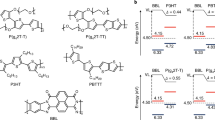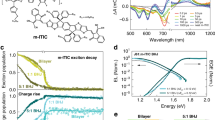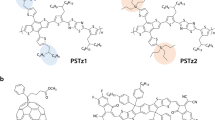Abstract
Heterojunctions between organic semiconductors are central to the operation of light-emitting and photovoltaic diodes, providing respectively for electron–hole capture and separation. However, relatively little is known about the character of electronic excitations stable at the heterojunction. We have developed molecular models to study such interfacial excited electronic excitations that form at the heterojunction between model polymer donor and polymer acceptor systems: poly(9,9-dioctylfluorene-co-bis-N,N-(4-butylphenyl)-bis-N,N-phenyl-1,4-phenylenediamine) (PFB) with poly(9,9-dioctylfluorene-co-benzothiadiazole) (F8BT), and poly(9,9-dioctylfluorene-co-N-(4-butylphenyl)diphenylamine) (TFB) with F8BT. We find that for stable ground-state geometries the excited state has a strong charge-transfer character. Furthermore, when partly covalent, modelled radiative lifetimes (∼10−7 s) and off-chain axis polarization (30∘) match observed ‘exciplex’ emission. Additionally for the PFB:F8BT blend, geometries with fully ionic character are also found, thus accounting for the low electroluminescence efficiency of this system.
This is a preview of subscription content, access via your institution
Access options
Subscribe to this journal
Receive 12 print issues and online access
$259.00 per year
only $21.58 per issue
Buy this article
- Purchase on Springer Link
- Instant access to full article PDF
Prices may be subject to local taxes which are calculated during checkout






Similar content being viewed by others
References
Morteani, A. C. et al. Barrier-free electron–hole capture in polymer blend heterojunction light-emitting diodes. Adv. Mater. 15, 1708–1712 (2003).
Halls, J. J. M. et al. Efficient photodiodes from interpenetrating polymer networks. Nature 376, 498–500 (1995).
Arias, A. C. et al. Photovoltaic performance and morphology of polyfluorene blends: A combined microscopic and photovoltaic investigation. Macromolecules 34, 6005–6013 (2001).
Brabec, C. J., Sariciftci, N. S. & Hummelen, J. C. Plastic solar cells. Adv. Funct. Mater. 11, 15–26 (2001).
Halls, J. J. M. et al. Charge- and energy-transfer processes at polymer/polymer interfaces: A joint experimental and theoretical study. Phys. Rev. B 60, 5721–5727 (1999).
Cao, Y., Parker, I. D., Yu, G., Zhang, C. & Heeger, A. J. Improved quantum efficiency for electroluminescence in semiconducting polymers. Nature 397, 414–417 (1999).
Palilis, L. C. et al. High performance blue light-emitting diodes based on conjugated polymer blends. Synth. Met. 121, 1729–1730 (2001).
McNeill, C. R., Westenhoff, S., Groves, C., Friend, R. H. & Greenham, N. C. Influence of nanoscale phase separation on the charge generation dynamics and photovoltaic performance of conjugated polymer blends: Balancing charge generation and separation. J. Phys. Chem. C 111, 19153–19160 (2007).
Morteani, A. C., Sreearunothai, P., Herz, L. M., Friend, R. H. & Silva, C. Exciton regeneration at polymeric semiconductor heterojunctions. Phys. Rev. Lett. 92, 247402 (2004).
Morteani, A. C., Friend, R. H. & Silva, C. Endothermic exciplex–exciton energy-transfer in a blue-emitting polymeric heterojunction system. Chem. Phys. Lett. 391, 81–84 (2004).
Sreearunothai, P. et al. Influence of copolymer interface orientation on the optical emission of polymeric semiconductor heterojunctions. Phys. Rev. Lett. 96, 117403 (2006).
Bittner, E. R., Ramon, J. G. S. & Karabunarliev, S. Exciton dissociation dynamics in model donor–acceptor polymer heterojunctions. I. Energetics and spectra. J. Chem. Phys. 122, 214719 (2005).
Ramon, J. G. S. & Bittner, E. R. Excited state calculations on fluorene-based polymer blends: Effect of stacking orientation and solvation. J. Chem. Phys. 126, 181101 (2007).
Jenekhe, S. A. & Osaheni, J. A. Excimers and exciplexes of conjugated polymers. Science 265, 765–768 (1994).
Granlund, T., Pettersson, L. A. A., Anderson, M. R. & Inganäs, O. Interference phenomenon determines the color in an organic light emitting diode. J. Appl. Phys. 81, 8097–8104 (1997).
Gebler, D. D., Wang, Y. Z., Fu, D.-K., Swager, T. M. & Epstein, A. J. Exciplex emission from bilayers of poly(vinyl carbazole) and pyridine based conjugated copolymers. J. Chem. Phys. 108, 7842–7848 (1998).
Offermans, T., van Hal, P. A., Meskers, S. C. J., Koetse, M. M. & Janssen, R. A. J. Exciplex dynamics in a blend of π-conjugated polymers with electron donating and accepting properties: MDMO-PPV and PCNEPV. Phys. Rev. B 72, 045213 (2005).
Weller, A. The Exciplex 23–38 (Academic, New York, 1975).
Xia, Y. & Friend, R. H. Controlled phase separation of polyfluorene blends via inkjet printing. Macromolecules 38, 6466–6471 (2005).
Gould, I. R., Young, R. H., Mueller, L. J., Albrecht, A. C. & Farid, S. Electronic structure of exciplexes and excited charge-transfer complexes. J. Am. Chem. Soc. 116, 8188–8199 (1994).
Valeur, B. Molecular Fluorescence Ch. 5 (Wiley-VCH Verlag GmbH, Weinheim, 2002).
Mihailetchi, V. D., Koster, L. J. A., Hummelen, J. C. & Blom, P. W. M. Photocurrent generation in polymer–fullerene bulk heterojunctions. Phys. Rev. Lett. 93, 216601 (2004).
Becke, A. D. Density-functional thermochemistry. III. The role of exact exchange. J. Chem. Phys. 98, 5648–5652 (1993).
Lee, C., Yang, W. & Parr, R. G. Development of the Colle–Salvetti correlation-energy formula into a functional of the electron density. Phys. Rev. B 37, 785–789 (1988).
Cornil, J. et al. Electronic and optical properties of polyfluorene and fluorene-based copolymers: A quantum-chemical characterization. J. Chem. Phys. 118, 6615–6623 (2003).
Accelrys, Inc. Cerius2 and Discover (programs) and Discover User Guide (Molecular Simulations, Inc., San Diego, 1996).
Ridley, J. & Zerner, M. C. An intermediate neglect of differential overlap technique for spectroscopy: Pyrrole and the azines. Theor. Chim. Acta 32, 111–134 (1973).
Mataga, N. & Nishimoto, K. Electronic structure and spectra of nitrogen heterocycles. Z. Phys. Chem. Neue. Folge. 13, 140–157 (1957).
Chandross, M. & Mazumdar, S. Coulomb interactions and linear, nonlinear, and triplet absorption in poly(para-phenylenevinylene). Phys. Rev. B 55, 1497–1504 (1997).
Westenhoff, S. et al. Supramolecular electronic coupling in chiral oligothiophene nanostructures. Adv. Mater. 18, 1281–1285 (2006).
Silva, C. et al. Exciton and polaron dynamics in a step-ladder polymeric semiconductor: The influence of interchain order. J. Phys. Condens. Matter 14, 9803–9824 (2002).
Acknowledgements
We thank J. S. Kim and W. J. D. Beenken for discussions. This work was supported by the Engineering and Physical Science Research Council, and by the EU Integrated Project NAIMO (No NMP4-CT-2004-500355). The work in Mons was partly supported by the Belgian Federal Government ‘Interuniversity Attraction Pole in Supramolecular Chemistry and Catalysis, PAI 5/3’, the Belgian National Fund for Scientific Research (FNRS/FRFC) and the European STREP project MODECOM (NMP-CT-2006-016434). D.B. is a research director of FNRS.
Author information
Authors and Affiliations
Contributions
Y.-S.H., I.A., P.S. and C.D. carried out the modelling. S.W. and J.M.H. measured the photoluminescence anisotropy. Y.-S.H., S.W., R.H.F. and D.B. analysed data, interpreted results and wrote the paper. All authors provided comments on the manuscript. R.H.F. contributed to the interpretation of the combined modelling and experimental work. D.B. and R.H.F. directed the research.
Corresponding authors
Rights and permissions
About this article
Cite this article
Huang, Ys., Westenhoff, S., Avilov, I. et al. Electronic structures of interfacial states formed at polymeric semiconductor heterojunctions. Nature Mater 7, 483–489 (2008). https://doi.org/10.1038/nmat2182
Received:
Accepted:
Published:
Issue Date:
DOI: https://doi.org/10.1038/nmat2182
This article is cited by
-
Acoustic extraordinary transmission manipulation based on proximity effects of heterojunctions
Scientific Reports (2019)
-
Hot exciton dissociation in polymer solar cells
Nature Materials (2013)
-
Molecular dynamics study of pair interactions, interfacial microstructure, and nanomorphology of C60/MEH-PPV hybrids
Journal of Polymer Research (2013)
-
Organic light-emitting diodes employing efficient reverse intersystem crossing for triplet-to-singlet state conversion
Nature Photonics (2012)
-
Polarized X-ray scattering reveals non-crystalline orientational ordering in organic films
Nature Materials (2012)



